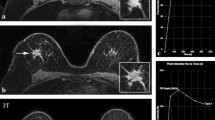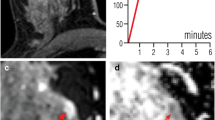Abstract
We evaluated the performance of low-field MRI in breast disorders by comparing it with high-field MRI and biopsy results. Twenty-eight consecutive patients who were able to undergo two magnetic resonance examinations on following days were examined by high-field and low-field MRI. After T1-weighted sagittal images had been obtained a dynamic 3D axial study was performed followed by the acquisition of contrast-enhanced T1-weighted sagittal images. The images were analyzed separately by two radiologists paying attention to lesion morphology and enhancement kinetics. Six patients had problems in both breasts (34 breasts studied). The results were compared with biopsy results of 27 breasts. There were 16 malignant lesions, two fibroadenomas and nine other benign lesions. The inter-magnetic-resonance-scanner κ value was 0.77 (substantial agreement), while the interobserver κ value was 0.86 and 0.81 at low and high field, respectively (excellent agreement). The sensitivity was 100 and 100%, the specificity was 82 and 73% and the accuracy was 93 and 89% at low and high field, respectively. The mean lesion size was 2 cm and the smallest malignant lesion was 8 mm in diameter. Low-field MRI is a promising tool for breast imaging. Larger materials and smaller lesions are needed to evaluate its true sensitivity and specificity.


Similar content being viewed by others
References
Heywang SH, Wolf A, Pruss E, Hilbertz T, Eiermann W, Permanetter W (1989) MR imaging of the breast with Gd-DTPA: use and limitations. Radiology 171:95–103
Kaiser WA, Zeitler E (1989) MR imaging of the breast: fast imaging sequences with and without Gd-DTPA. Preliminary observations. Radiology 170:681–686
Stomper PC, Herman S, Klippenstein DL et al (1995) Suspect breast lesions: findings at dynamic gadolinium-enhanced MR imaging correlated with mammographic and pathologic features. Radiology 197:387–395
Nunes LW, Schnall MD, Orel SG et al (1997) Breast MR imaging: interpretation model. Radiology 202:833–841
Liu PF, Debatin JF, Caduff RF, Kacl G, Garzoli E, Krestin GP (1998) Improved diagnostic accuracy in dynamic contrast enhanced MRI of the breast by combined quantitative and qualitative analysis. Br J Radiol 71:501–509
Kuhl CK, Mielcareck P, Klaschik S et al (1999) Dynamic breast MR imaging: are signal intensity time course data useful for differential diagnosis of enhancing lesions? Radiology 211:101–110
Baum F, Fischer U, Vosshenrich R, Grabbe E (2002) Classification of hypervascularized lesions in CE MR imaging of the breast. Eur Radiol 12:1087–1092
Obdeijn IM, Kuijpers TJ, van Dijk P, Wiggers T, Oudkerk M (1996) MR lesion detection in a breast cancer population. J Magn Reson Imaging 6:849–854
Lee CH, Smith RC, Levine JA, Troiano RN, Tocino I (1999) Clinical usefulness of MR imaging of the breast in the evaluation of the problematic mammogram. Am J Roentgenol 173:1323–1329
Weinstein SP, Orel SG, Heller R et al (2001) MR imaging of the breast in patients with invasive lobular carcinoma. Am J Roentgenol 176:399–406
Orel SG, Schnall MD, Powell CM et al (1995) Staging of suspected breast cancer: effect of MR imaging and MR-guided biopsy. Radiology 196:115–122
Fischer U, Kopka L, Grabbe E (1999) Breast carcinoma: effect of preoperative contrast-enhanced MR imaging on the therapeutic approach. Radiology 213:881–888
Muuller RD, Barkhausen J, Sauerwein W, Langer R (1998) Assessment of local recurrence after breast-conserving therapy with MRI. J Comput Assist Tomogr 22:408–412
Viehweg P, Heinig A, Lampe D, Buchmann J, Heywang-Kobrunner SH (1998) Retrospective analysis for evaluation of the value of contrast-enhanced MRI in patients treated with breast conservative therapy. Magma 7:141–152
Morris EA, Schwartz LH, Dershaw DD, van Zee KJ, Abramson AF, Liberman L (1997) MR imaging of the breast in patients with occult primary breast carcinoma. Radiology 205:437–440
Heywang-Kobrunner SH, Huynh AT, Viehweg P, Hanke W, Requardt H, Paprosch I (1994) Prototype breast coil for MR-guided needle localization. J Comput Assist Tomogr 18:876–881
Orel SG, Schnall MD, Newman RW, Powell CM, Torosian MH, Rosato EF (1994) MR imaging-guided localization and biopsy of breast lesions: initial experience. Radiology 193:97–102
Kuhl CK, Morakkabati N, Leutner CC, Schmiedel A, Wardelmann E, Schild HH (2001) MR imaging-guided large-core (14-gauge) needle biopsy of small lesions visible at breast MR imaging alone. Radiology 220:31–39
Ojala R, Sequeiros RB, Klemola R, Vanhala E, Jyrkinen L, Tervonen O (2002) MR-guided bone biopsy—preliminary report of a new guiding method. J Magn Reson Imaging 15:82–86
Sittek H, Perlet C, Herrman K, Linsmeier E, Kolem H, Untch M, Kessler M, Reiser M (1997) MR mammography. Preoperative marking of non-palpable breast lesions with the magnetom open at 0.2 T. Radiologe 37:685–691
Palosaari K, Tervonen O (2002) Post-processing water-fat imaging technique for fat suppression in a low-field MR imaging system, evaluation in patients with rheumatoid arthritis. Magma 15:1–9
Landis JR, Koch GG (1977) The measurement of observer agreement for categorical data. Biometrics 33:159–174
Orel SG, Schnall MD (2001) MR imaging of the breast for the detection, diagnosis and staging of breast cancer. Radiology 220:13–30
Sardanelli F, Iozelli A, Fausto A (2003) MR imaging of the breast: indications, established technique and new directions. Eur Radiol 13(Suppl 3):N28–N36
Vomweg TW, Teifke A, Kunz RP, Hintze C, Hlawatsch A, Kern A, Kreitner KF, Thelen M (2004) Combination of low and high resolution sequences in two orientations for dynamic contrast-enhanced MRI of the breast: more than a compromise. Eur Radiol 14:1732–1742
Reinikainen H, Paakko E, Suramo I, Paivansalo M, Jauhiainen J, Rissanen T (2002) Dynamics of contrast enhancement in MR imaging and power Doppler ultrasonography of solid breast lesions. Acta Radiol 43:492–500
Hittmair K, Turetschek K, Gomiscek G, Stiglblauer R, Schurawitzki H (1996) Field strength dependence of MRI contrast enhancement: phantom measurements and application to dynamic breast imaging. Br J Radiol 69:215–220
Author information
Authors and Affiliations
Corresponding author
Rights and permissions
About this article
Cite this article
Pääkkö, E., Reinikainen, H., Lindholm, EL. et al. Low-field versus high-field MRI in diagnosing breast disorders. Eur Radiol 15, 1361–1368 (2005). https://doi.org/10.1007/s00330-005-2664-6
Received:
Revised:
Accepted:
Published:
Issue Date:
DOI: https://doi.org/10.1007/s00330-005-2664-6




